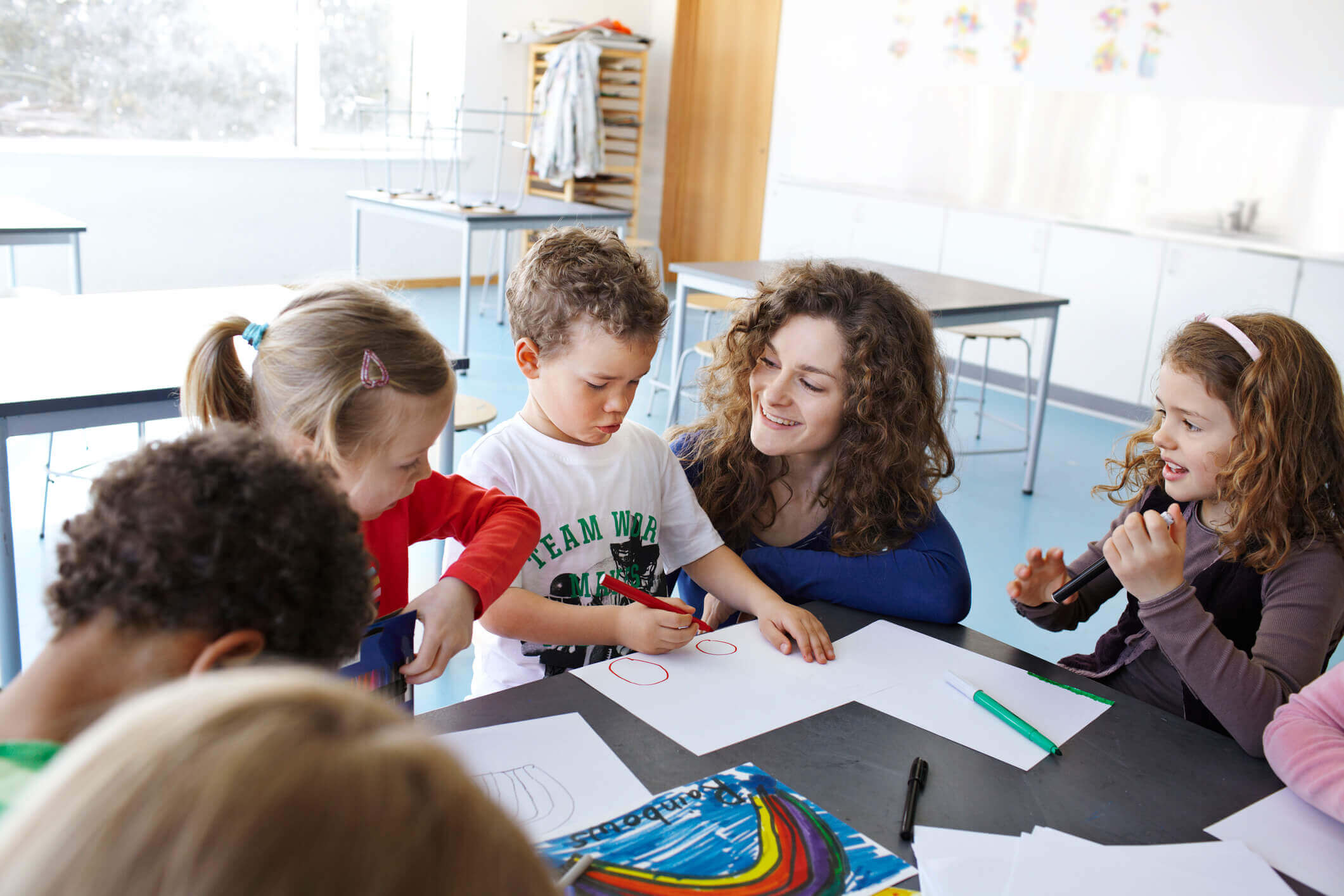Are you looking for strategies to improve inclusion in the classroom and help all of your students to feel comfortable, valued and able to contribute equitably to learning activities?
As we will see over the course of this article, designing inclusive learning environments has been demonstrated to have a positive impact on all students – not just those directly impacted by their design.
We’ll take some time to understand the nature of inclusion and its place in education before examining some of the benefits and finally thinking about how to create an inclusive classroom. You can use the links below to navigate through the article:
- What is inclusion?
- What’s the difference between accessibility and inclusion?
- What is inclusion in education?
- What are the benefits of inclusion in the classroom?
- How can we create an inclusive learning environment?
- What are some inclusive education examples?
- Improving inclusion in the classroom with Promethean
What is Inclusion?
Inclusion is the practice of ensuring that everyone is included and accommodated within a group, space or activity, and is afforded equal opportunities. It’s about treating everyone in our communities with dignity and respect, ensuring that they are valued, and their needs considered. Inclusion accounts for the treatment not only of those with protected characteristics (such as disability, religion or race) but to anyone who might have a different set of needs. As an example, consider colleagues who work part-time, have caring responsibilities, are second-language speakers, or suffer from anxiety, and think about how their workplace needs might differ from yours.
What’s the Difference Between Accessibility and Inclusion?
Although part of the same parlance, there is a subtle difference between accessibility and inclusion.
Accessibility is about removing any barriers that might prevent a person from fully accessing a space or taking part in an activity. Inclusion is about designing that space or activity to be inclusive of everyone’s needs in the first place, regardless of their ability, lifestyle or background.
Let’s view this through the lens of an inclusive classroom example and imagine we’ve built a new mobile classroom to accommodate our expanding student numbers. There are three steps leading up to the entrance of our new classroom and we’ve asked every child to memorise a four-digit key code that admits them to the building. We then learn that next year’s class will include one wheelchair user and a child with severe dyscalculia, so we need to make our new space accessible to those users. We might decide to build a ramp to the entrance and replace the key code system with a digital key fob.
Had we taken an inclusive design approach in the first instance, we might have raised the ground in front of the door to prevent the need for steps or ramps, and we might have installed an automatic door.
In other words, if we design our spaces and activities in an inclusive manner in the first place, there should be no need for us to have to retrospectively consider accessibility.

What is Inclusion in Education?
Putting a definition to inclusive education is a task that has sparked fierce debate in the UK, and you may find that your perspective will depend upon the tools and resources for teaching that you have access to.
Usually when we talk about an inclusive learning environment, we are referring to students with a diverse set of needs and abilities all learning alongside one another in a shared environment that caters to those individual needs. Ideally, this will see the incorporation of adaptive learning activities that allow each student to showcase their individual strengths and participate unimpeded in all activities. This is the definition that we’ll adopt throughout this article.
It’s important to recognise, however, that there is an argument that inclusive education can only be achieved if children with learning difficulties or disabilities are educated in separate learning environments that cater specifically to their needs. While the challenges of catering to the individual needs of every child in a classroom are evident, it should be noted that this involves a much narrower interpretation of inclusion. As we’ve already discussed, real inclusion goes beyond disability and learning differences.
Though the opinions on the optimal implementation of inclusive education differ, there is one thing that both parties agree on; inclusion entails the provision of equal opportunities to all learners and requires us to adapt our teaching style to their particular needs.
What are the Benefits of Inclusion in the Classroom?
There has been plenty of research examining the impact of inclusive learning environments on disabled students.
A 2012 study found that disabled students who spent a larger proportion of their school day with non-disabled peers performed significantly better in mathematics and languages than those who spent a smaller proportion of their day with non-disabled peers. This study has been replicated with multiple variables, each demonstrating improved academic measures for disabled students taught in an inclusive environment.
Notably, the benefits experienced by these students are not just academic. Further studies have shown that disabled students who are taught in inclusive learning environments are more likely to belong to school groups, more likely to go into competitive employment, more likely to live independently, and less likely to receive disciplinary referrals.
The benefits of inclusive education for disabled students appear to be comprehensive but recent studies have shown that they are not the only groups to profit from inclusion. A 2021 study into inclusive interactive learning environments demonstrated that non-disabled students who were educated alongside disabled students experienced a range of benefits, including:
- learning to respect others and acknowledge different abilities, allowing new friendships to develop;
- learning to help others participate and learn, and developing patience and satisfaction in helping others;
- cognitive benefits in learning to express themselves in an accessible manner, and to learn from the contributions of their disabled peers.
Further studies have demonstrated that, when taught in inclusive settings, students without disabilities made significantly greater progress in reading and mathematics, and saw increased overall academic achievement when providing peer support for students with disabilities.
It seems then, that inclusion in the classroom has a tangible benefit for everyone, improving tolerance, empathy, communication, social integration, and academic performance.
How Can We Create an Inclusive Learning Environment?
Most effective inclusive education is built upon the Universal Design for Learning (UDL) framework, which is based around the principle that barriers to learning come not from the learner themselves but from the circumstances of their environment.
UDL requires teachers to plan for learner variability and to include a variety of methodical variations to make classroom activities accessible to all students. This means ensuring that all learners are motivated to learn, have their individual educational needs met, and are empowered to engage in their lessons.

What are Some Inclusive Classroom Examples?
So now that we understand the principles behind how to create an inclusive classroom, how do we put those principles into practice? Below are some inclusive education examples.
Physically Accessible Environments
Perhaps the most obvious inclusion in the classroom example, but often one of the most logistically challenging to implement, is making sure that our physical spaces meet the needs of all students. Do wheelchair users have the space to manoeuvre around the classroom unimpeded? Do we have adjustable desks or a range of seating options to suit the various needs of our students? We should consider elements of the room that might prove overstimulating for some learners, such as the lighting or the volume of our devices. We’ll also need to make sure that we have access to assistive technologies.
Accessible Formats
This is as simple as ensuring that all students can understand and engage with the tools that we use to teach a lesson. For example, if we’re playing a video to the class and we have a child with a hearing impairment, we need to make sure that we’ve enabled the video captions. If we have dyslexic children in our class, we can consider avoiding the use of black text on a white background, or we can provide coloured filters to reduce the colour contrast. For those with visual impairments, we can make sure they have access to a screen reader.
Representational Role Models
A key to creating a truly inclusive learning environment is presenting students with role models and scenarios that they can identify with. This starts with ensuring that you have a diverse workforce comprised of teachers from a range of backgrounds, lifestyles and with a varied set of abilities. It can also be considered within the subject matter that we’re teaching. For example, in our literature lessons, instead of studying texts by western white male authors, we could adopt an intersectional approach, including female authors, black authors, disabled authors, authors from low socio-economic backgrounds, LGBT authors and so on. Exposure to diverse role models has also been shown to have a positive motivational impact on all students.
Creating a Safe Space
Real inclusion exists when the contributions of all members of society are received with respect. In the classroom, this can only happen when teachers set clear expectations and standards of behaviour so that all students feel comfortable to express themselves or to ask questions without fear of retribution. This needs to be reinforced with firm boundaries and clear consequences for transgressions.
Removing Barriers to Participation
Most teachers will be accustomed to watching the same hands shoot up in response to a question and yet we know that a lack of proactive engagement does not always correlate to cognitive understanding. There are many reasons a student may not feel comfortable engaging in class – perhaps that aforementioned safe space hasn’t been established, or maybe they have severe social anxiety. If you use digital tools in the classroom, then the integration of anonymised software applications such as Kahoot! or Mentimeter allows students to contribute in a way that makes them feel comfortable and helps to build their confidence. If you’re using Promethean’s teaching software ActivInspire, you’ll find Kahoot! free to download in the app store.
Multiple Assessment Types
Teachers who selected their undergraduate university modules based on the assessment method will be well aware of how different assessment formats can favour different learners. All students will have a preference between exams, coursework and group projects and this is in no small part due to a variation in learning styles. A truly inclusive learning environment by necessity requires inclusive assessment and this means giving students a variety of ways in which to demonstrate their learning.
Collaborative Learning
Allowing students to learn in small groups gives them the opportunity to collaborate with those they might not otherwise speak to. They have the chance to share different perspectives, learn from those with different backgrounds and ultimately improve their communication skills and develop a stronger sense of empathy. Using interactive displays in our classrooms is an effective way to allow working groups to present their thoughts back to the class, as they can express themselves in a manner that suits them, whether that’s by drawing diagrams and pictures or through the use of interactive games. They can even connect their own devices to a panel to share their work with the class.
Improving Inclusion in the Classroom with Promethean
To find out more about how Promethean products can help you to develop an inclusive learning environment for your classroom, contact us for a free demo of the Promethean ActivPanel.
Recommended reading:


